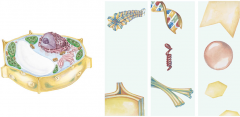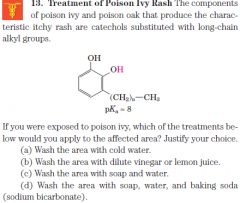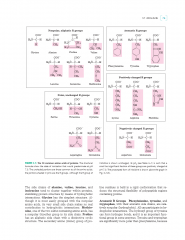![]()
![]()
![]()
Use LEFT and RIGHT arrow keys to navigate between flashcards;
Use UP and DOWN arrow keys to flip the card;
H to show hint;
A reads text to speech;
49 Cards in this Set
- Front
- Back
|
What defines a cell?
|
The plasma membrane that separates its contents from the surroundings. Enclosed in this membrane is cytoplasm.
|
|
|
What are the key elements within the cytoplasm?
|
1) Cytosol - concentrated aqueous solution with enzymes and RNA
2) metabolites - biosynthetic and degradative 3) coenzymes - enzyme-catalyzed reactions 4) ribosomes - protein synthesis 5) proteosomes - degrade unneeded proteins |
|
|
Two main families of organisms?
|
1) Eukaryotes - contain a nuclear envelope; multicelled; DNA in nucleus; multi-compartmented
2) Prokaryotes - don't contain a nuclear envelope; DNA in nucleoid; plasmids a. Arcahea - harsh environments (closer to eurkaryotes) b. Bacteria - inhabit soils, surface H2O, and tissue |
|
|
What is compartmentalization?
|
Prevents loss of compounds (diffusion) and pH change
|
|
|
Why are large surface area-volume ratios important?
|
1) Every part is easily accessible to outside molecules
2) Metabolism: allows faster O2 diffusion than consumption |
|
|
What is a cytoskeleton made up of?
|
1) filaments
2) microtubules 3)intermediate filaments |
|
|
What are some important functions of cytoskeletons?
|
1)endomembrane system: metabolic processes and ezyme-catalyzed reactions
2)exocytosis/endocytosis: fusion/fission which provides paths between cytoplasm and environment 3)noncovalent, reversible, subject to regulation |
|
|
Supermolecular compounds -> Macromolecules -> Monomeric Units
|

Chromatin -> DNA -> Nucleotides
Plasma Membrane -> Protein -> Amino Acid Cell Wall -> Cellulose -> Sugars SPM) Noncovalent/hydrogen/ionic/hydrophobic/vanderwaals MA) Noncovalent/hydrogen/ionic/hydrophobic/vanderwaals MO) covalent |
|
|
What are the most abundant elements in a biological system?
|
1) Hydrogen
2) Oxygen 3) Nitrogen 4) Carbon |
|
|
What are some additional things in cytosol?
|
1) Amino acids, nucleotides, sugars, and their derivatives
a. polar, charged, water soluble, [micromolar-millimolar] b. cell membrane impermeable to these 2) Secondary metabolites: plant smell, morphine, nicotine, caffeine 3)metabolomes |
|
|
What are some additional macromolecules?
|
1) Polysaccharides: polomers of simple sugars (glucose)
2) Lipids: water-insoluble hydrocarbon dervatives a. energy-rich fuel stores b. pigments c. intracellular signals d. membranes e. intracellular signals |
|
|
Why is it important that proteins and nucleic acids are linear polymers of monomeric subunits?
|
This gives each molecule its three-dimensional structure which governs biological function and reactivity
|
|
|
Why are stereoisomers important?
|
Biological systems are stereospecific
|
|
|
What are the three types of systems?
|
1) isolated: no energy or mass exchange
2) closed: only energy exchange 3) open: both energy and mass exchange |
|
|
What does the sign on Gibbs free energy mean?
|
-deltaG = exogernic = towards completion
+deltaG = endogernic = tends to run in the reverse |
|
|
What are the main sources of energy?
|
1) Oxidizing environmental fuels
2) Absorption of sunlight |
|
|
What is an enzyme?
|
A biological catalyst which determines how matter and energy are channeled into cellular activities
|
|
|
What is catabolism?
|
Free energy yielding reactions
|
|
|
What does it mean to be chiral?
|
To have at least two arrangements that are not superimposable onto each other.
|
|
|
Important structures of:
1) amino acids 2) fatty acids 3) nucleotides |
1) Nitrogenous substituents
2) Long hydrocarbon chains 3) Nitrogen base, 5carbon Sugar, Phosphate |
|
|
What is activation energy?
|
The amount of energy needed to convert 1 mol of molecules to the transition state
|
|
|
What is required of a substance to be detected as different by the human body?
|
The substance must be structurally different. The source of the substance does not matter
|
|
|
What are some important characteristics of water?
|
1) Difference in EN between Oxygen and Hydrogen create a net dipole, making water very polar
2) Has a strong ability to hydrogen with itself and other molecules which contain dipoles created by a difference in EN. 3) The above justify water as a good solvent for polar(hydrophilic) solutes |
|
|
What are the types of bonding ordered strongest to weakest?
|
1) covalent: sharing of electrons
2) ionic: involves formal charges 3/4) hydrogen: differences in EN 3/4) hydrophobic: results when nonpolar and polar are mixed; nonpolar minimizes exposure to polar (shifts towards disorder rather than order) 5) Van der Waals: attractive force between two atoms, becomes repulsive if too close |
|
|
If noncovalent bonds are so weak, why are they found in biological systems?
|
Within the big picture, the sum of all the noncovalent interactions is quite large. Noncovalent interactions are largely responsible for the way macromolecules "fold" into their 3-dimensional shape
|
|
|
What is osmotic pressure?
|
When water moves across the barrier between two aqueous layers to equalize osmolarity.
|
|
|
What are the products of the ionization of water?
|
H3O+ and OH-
|
|
|
As pka increases acidity ___?
|
Decreases
|
|
|
What is a buffer?
|
Combination of weak acid/base and their conjugate which resists change by reacting with any additional acid/base added
|
|
|
Hinderson-Haselbach equation?
|
pH = pka + log[A-]/[HA]
|
|
|
Calculating changes upon addition of....
1) acid 2) base |
1) [A-] - [Added Acid] ; [HA] + [Added Acid]
2) [A-] + [Added Base] ; [HA] - [Added Base] |
|

|
I would choose (d) because it involves a nonionic compound with a long hydrocarbon chain which is insoluble in water. In order to dissolve we must first deprotonate with base (sodium bicarbonate).
|
|
|
What happens when pH >> pka of a particular substituent?
|
The substituent becomes deprotonated
|
|
|
What do all 21 amino acids have in common?
|
1) alpha-carbonyl group
2) alpha-amino group 3) alpha-carbon substituent |
|
|
What is unique only to glycine?
|
The alpha-carbon is symmetric = no stereoisomers
|
|
|
What are the 21 amino acids?
|

Major Roles:
1) monomers 2) chemical messengers 3) energy (oxidation) 4) buffer 5) allergies 6) protection 7) osmosis modulators |
|
|
Aromatic Amino Acids
|
1)Phenyalanine
2) Tyrosine 3) Tryptophan Relatively nonpolar Participate in hydrophobic reactions Hydroxyl groups can hydrogen bond T's more polar than Phenylalanine Absorb UV light |
|
|
Polar Uncharged Amino Acid
|
1) Serine
2) Threonine 3) Cysteine 4) Selenocysteine 5) Asparagine 6) Glutamine More soluble in water b/c of H-bond Disulfide bonds create covalent links between polypeptides |
|
|
Positively Charged Amino Acids
|
1) Lysine
2) Arginine 3) Histidine Very soluble in water (charged) Histidine both charged and uncharged @ pH7 Histidine serves as proton donator/acceptor |
|
|
Negatively Charged Amino Acids
|
1) Aspartate
2) Glutamate 2 carboxyl groups |
|
|
How are peptides and proteins formed?
|
Through covalent peptide bonds between multiple amino acids
|
|
|
How are peptide bonds formed?
|
Removal of elements of water from alpha-carboxyl group of one amino acid and the alpha-amino group of another. This requires energy input!
|
|
|
What is the function of a peptide?
|
There are several, but the most general is being a building block for protein
|
|
|
What are some common separation techniques?
|
1) Column Chromatography: charge/polarity/affinity
2) TLC: polarity 3) Centrifuge: size/density 4) Electrophoresis: charge/size/viscosity 5) Sodium Dodecyl Sulfate (PAGE): charge/size/viscosity ; impedes movement of large molecules ; protein reduced and denatured PAGE = polyacrylamide gel electophoresis |
|
|
How are amino acids analyzed?
|
Complete hydrolysis of polypeptides/proteins
|
|
|
Nonpolar, alipathic Amino Acids
|
1) Glycine
2) Alanine 3) Proline 4) Valine 5) Leucine 6) Isoleucine 7) Methionine |
|
|
Nonpolar, nonaromatic
|
1) Glycine
2) Alanine 3) Proline 4) Valine 5) Leucine 6) Isoleucine 7) Methionine |
|
|
What are the four levels of protein structure?
|
1) Primary: simple AA sequence
2) Secondary: interaction of closely linked primary AA 3) Tertiary: interactions of far away primary AA 4) Quaternary: interactions of subunits; more than one protein |
|
|
What are some secondary protein shapes?
|
1) helix (slinky)
2) sheets (accordion) 3) random (inconsistent bond angles) |

